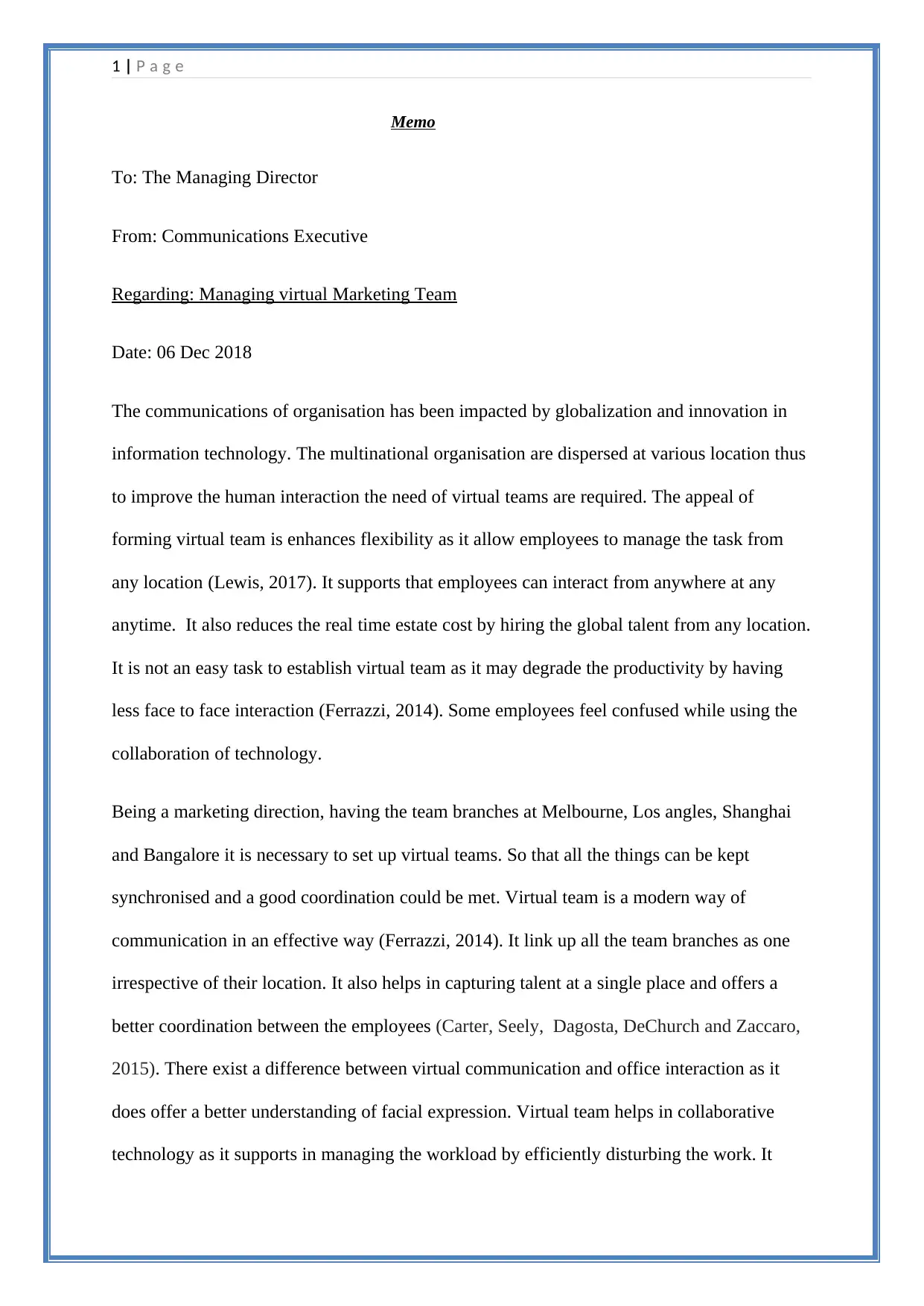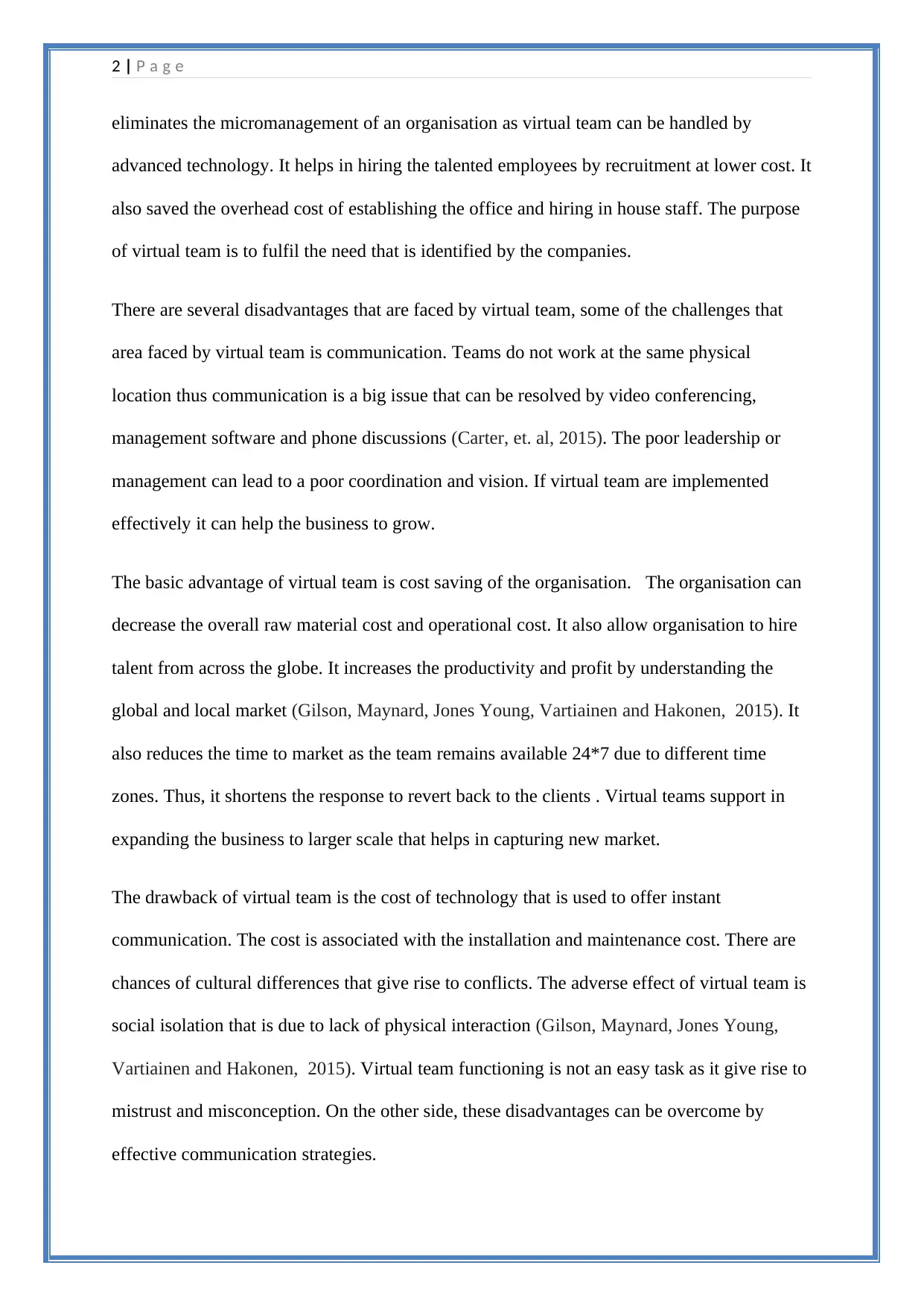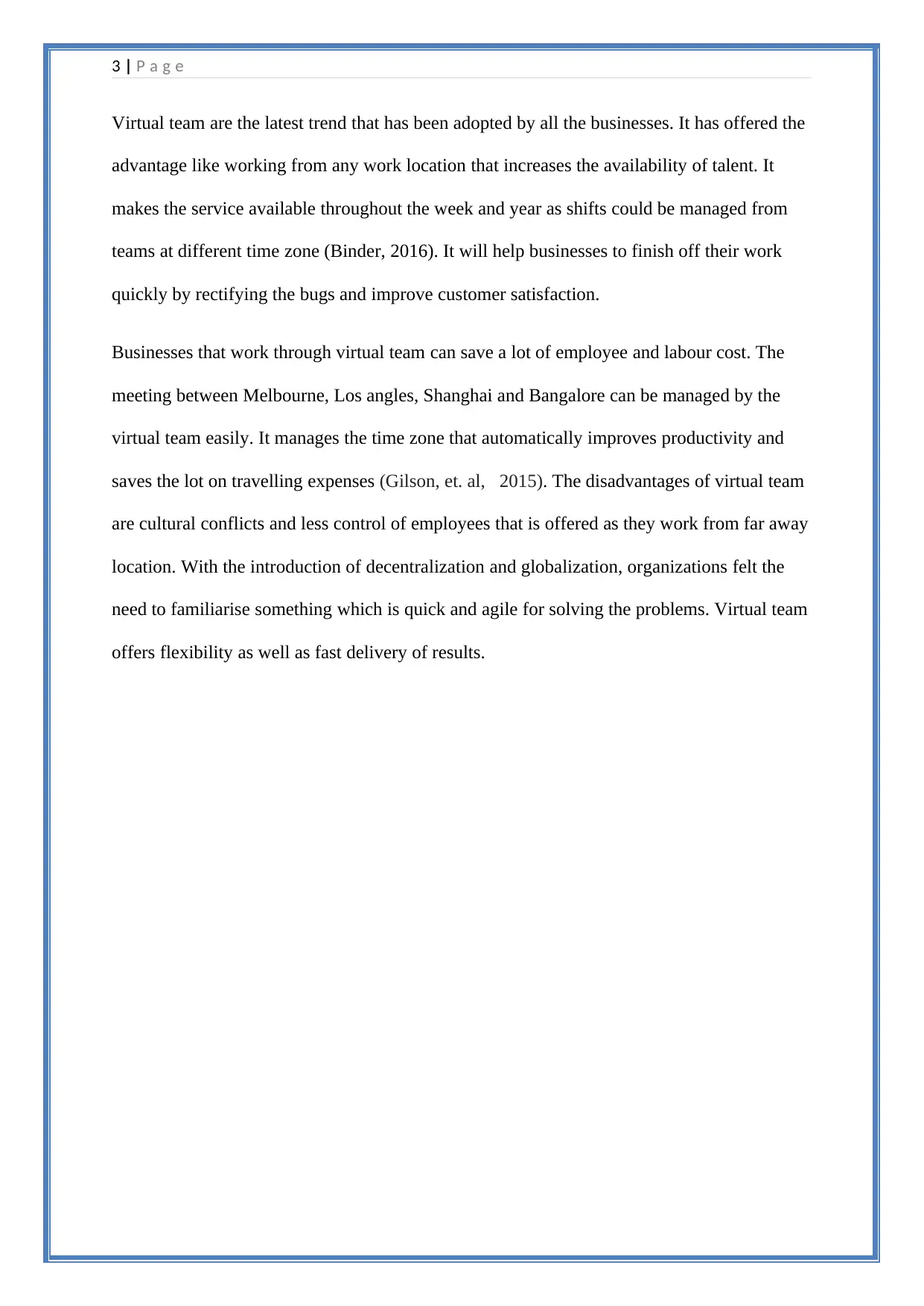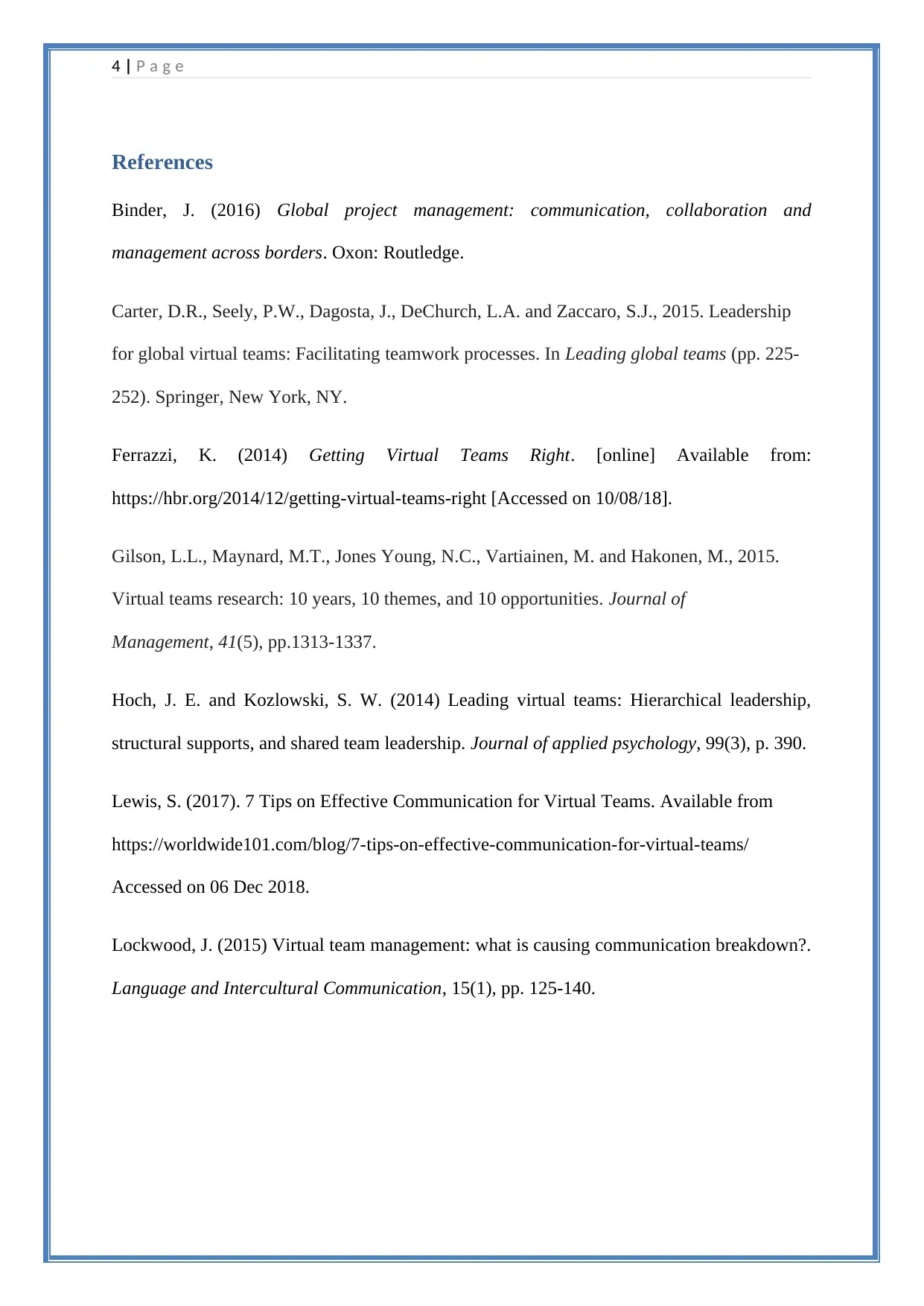MNG81001: Effective Communication Strategies for Virtual Teams
VerifiedAdded on 2023/05/28
|5
|1132
|229
Report
AI Summary
This report explores the impact of globalization and technology on organizational communication, focusing on the necessity of virtual teams for multinational organizations. It highlights the advantages of virtual teams, such as increased flexibility, access to global talent, and reduced real estate costs. It also addresses challenges like communication barriers and potential for reduced face-to-face interaction. The report provides insights into effective strategies for managing virtual teams, including leveraging collaborative technology, addressing cultural differences, and mitigating social isolation. It concludes that while virtual teams present certain disadvantages, effective communication strategies can help businesses leverage their benefits, including cost savings, increased productivity, and expanded market reach. Desklib offers a wide range of study resources, including past papers and solved assignments, to support students in their academic endeavors.

Management Communication 75
0
0
Paraphrase This Document
Need a fresh take? Get an instant paraphrase of this document with our AI Paraphraser

1 | P a g e
Memo
To: The Managing Director
From: Communications Executive
Regarding: Managing virtual Marketing Team
Date: 06 Dec 2018
The communications of organisation has been impacted by globalization and innovation in
information technology. The multinational organisation are dispersed at various location thus
to improve the human interaction the need of virtual teams are required. The appeal of
forming virtual team is enhances flexibility as it allow employees to manage the task from
any location (Lewis, 2017). It supports that employees can interact from anywhere at any
anytime. It also reduces the real time estate cost by hiring the global talent from any location.
It is not an easy task to establish virtual team as it may degrade the productivity by having
less face to face interaction (Ferrazzi, 2014). Some employees feel confused while using the
collaboration of technology.
Being a marketing direction, having the team branches at Melbourne, Los angles, Shanghai
and Bangalore it is necessary to set up virtual teams. So that all the things can be kept
synchronised and a good coordination could be met. Virtual team is a modern way of
communication in an effective way (Ferrazzi, 2014). It link up all the team branches as one
irrespective of their location. It also helps in capturing talent at a single place and offers a
better coordination between the employees (Carter, Seely, Dagosta, DeChurch and Zaccaro,
2015). There exist a difference between virtual communication and office interaction as it
does offer a better understanding of facial expression. Virtual team helps in collaborative
technology as it supports in managing the workload by efficiently disturbing the work. It
Memo
To: The Managing Director
From: Communications Executive
Regarding: Managing virtual Marketing Team
Date: 06 Dec 2018
The communications of organisation has been impacted by globalization and innovation in
information technology. The multinational organisation are dispersed at various location thus
to improve the human interaction the need of virtual teams are required. The appeal of
forming virtual team is enhances flexibility as it allow employees to manage the task from
any location (Lewis, 2017). It supports that employees can interact from anywhere at any
anytime. It also reduces the real time estate cost by hiring the global talent from any location.
It is not an easy task to establish virtual team as it may degrade the productivity by having
less face to face interaction (Ferrazzi, 2014). Some employees feel confused while using the
collaboration of technology.
Being a marketing direction, having the team branches at Melbourne, Los angles, Shanghai
and Bangalore it is necessary to set up virtual teams. So that all the things can be kept
synchronised and a good coordination could be met. Virtual team is a modern way of
communication in an effective way (Ferrazzi, 2014). It link up all the team branches as one
irrespective of their location. It also helps in capturing talent at a single place and offers a
better coordination between the employees (Carter, Seely, Dagosta, DeChurch and Zaccaro,
2015). There exist a difference between virtual communication and office interaction as it
does offer a better understanding of facial expression. Virtual team helps in collaborative
technology as it supports in managing the workload by efficiently disturbing the work. It

2 | P a g e
eliminates the micromanagement of an organisation as virtual team can be handled by
advanced technology. It helps in hiring the talented employees by recruitment at lower cost. It
also saved the overhead cost of establishing the office and hiring in house staff. The purpose
of virtual team is to fulfil the need that is identified by the companies.
There are several disadvantages that are faced by virtual team, some of the challenges that
area faced by virtual team is communication. Teams do not work at the same physical
location thus communication is a big issue that can be resolved by video conferencing,
management software and phone discussions (Carter, et. al, 2015). The poor leadership or
management can lead to a poor coordination and vision. If virtual team are implemented
effectively it can help the business to grow.
The basic advantage of virtual team is cost saving of the organisation. The organisation can
decrease the overall raw material cost and operational cost. It also allow organisation to hire
talent from across the globe. It increases the productivity and profit by understanding the
global and local market (Gilson, Maynard, Jones Young, Vartiainen and Hakonen, 2015). It
also reduces the time to market as the team remains available 24*7 due to different time
zones. Thus, it shortens the response to revert back to the clients . Virtual teams support in
expanding the business to larger scale that helps in capturing new market.
The drawback of virtual team is the cost of technology that is used to offer instant
communication. The cost is associated with the installation and maintenance cost. There are
chances of cultural differences that give rise to conflicts. The adverse effect of virtual team is
social isolation that is due to lack of physical interaction (Gilson, Maynard, Jones Young,
Vartiainen and Hakonen, 2015). Virtual team functioning is not an easy task as it give rise to
mistrust and misconception. On the other side, these disadvantages can be overcome by
effective communication strategies.
eliminates the micromanagement of an organisation as virtual team can be handled by
advanced technology. It helps in hiring the talented employees by recruitment at lower cost. It
also saved the overhead cost of establishing the office and hiring in house staff. The purpose
of virtual team is to fulfil the need that is identified by the companies.
There are several disadvantages that are faced by virtual team, some of the challenges that
area faced by virtual team is communication. Teams do not work at the same physical
location thus communication is a big issue that can be resolved by video conferencing,
management software and phone discussions (Carter, et. al, 2015). The poor leadership or
management can lead to a poor coordination and vision. If virtual team are implemented
effectively it can help the business to grow.
The basic advantage of virtual team is cost saving of the organisation. The organisation can
decrease the overall raw material cost and operational cost. It also allow organisation to hire
talent from across the globe. It increases the productivity and profit by understanding the
global and local market (Gilson, Maynard, Jones Young, Vartiainen and Hakonen, 2015). It
also reduces the time to market as the team remains available 24*7 due to different time
zones. Thus, it shortens the response to revert back to the clients . Virtual teams support in
expanding the business to larger scale that helps in capturing new market.
The drawback of virtual team is the cost of technology that is used to offer instant
communication. The cost is associated with the installation and maintenance cost. There are
chances of cultural differences that give rise to conflicts. The adverse effect of virtual team is
social isolation that is due to lack of physical interaction (Gilson, Maynard, Jones Young,
Vartiainen and Hakonen, 2015). Virtual team functioning is not an easy task as it give rise to
mistrust and misconception. On the other side, these disadvantages can be overcome by
effective communication strategies.
⊘ This is a preview!⊘
Do you want full access?
Subscribe today to unlock all pages.

Trusted by 1+ million students worldwide

3 | P a g e
Virtual team are the latest trend that has been adopted by all the businesses. It has offered the
advantage like working from any work location that increases the availability of talent. It
makes the service available throughout the week and year as shifts could be managed from
teams at different time zone (Binder, 2016). It will help businesses to finish off their work
quickly by rectifying the bugs and improve customer satisfaction.
Businesses that work through virtual team can save a lot of employee and labour cost. The
meeting between Melbourne, Los angles, Shanghai and Bangalore can be managed by the
virtual team easily. It manages the time zone that automatically improves productivity and
saves the lot on travelling expenses (Gilson, et. al, 2015). The disadvantages of virtual team
are cultural conflicts and less control of employees that is offered as they work from far away
location. With the introduction of decentralization and globalization, organizations felt the
need to familiarise something which is quick and agile for solving the problems. Virtual team
offers flexibility as well as fast delivery of results.
Virtual team are the latest trend that has been adopted by all the businesses. It has offered the
advantage like working from any work location that increases the availability of talent. It
makes the service available throughout the week and year as shifts could be managed from
teams at different time zone (Binder, 2016). It will help businesses to finish off their work
quickly by rectifying the bugs and improve customer satisfaction.
Businesses that work through virtual team can save a lot of employee and labour cost. The
meeting between Melbourne, Los angles, Shanghai and Bangalore can be managed by the
virtual team easily. It manages the time zone that automatically improves productivity and
saves the lot on travelling expenses (Gilson, et. al, 2015). The disadvantages of virtual team
are cultural conflicts and less control of employees that is offered as they work from far away
location. With the introduction of decentralization and globalization, organizations felt the
need to familiarise something which is quick and agile for solving the problems. Virtual team
offers flexibility as well as fast delivery of results.
Paraphrase This Document
Need a fresh take? Get an instant paraphrase of this document with our AI Paraphraser

4 | P a g e
References
Binder, J. (2016) Global project management: communication, collaboration and
management across borders. Oxon: Routledge.
Carter, D.R., Seely, P.W., Dagosta, J., DeChurch, L.A. and Zaccaro, S.J., 2015. Leadership
for global virtual teams: Facilitating teamwork processes. In Leading global teams (pp. 225-
252). Springer, New York, NY.
Ferrazzi, K. (2014) Getting Virtual Teams Right. [online] Available from:
https://hbr.org/2014/12/getting-virtual-teams-right [Accessed on 10/08/18].
Gilson, L.L., Maynard, M.T., Jones Young, N.C., Vartiainen, M. and Hakonen, M., 2015.
Virtual teams research: 10 years, 10 themes, and 10 opportunities. Journal of
Management, 41(5), pp.1313-1337.
Hoch, J. E. and Kozlowski, S. W. (2014) Leading virtual teams: Hierarchical leadership,
structural supports, and shared team leadership. Journal of applied psychology, 99(3), p. 390.
Lewis, S. (2017). 7 Tips on Effective Communication for Virtual Teams. Available from
https://worldwide101.com/blog/7-tips-on-effective-communication-for-virtual-teams/
Accessed on 06 Dec 2018.
Lockwood, J. (2015) Virtual team management: what is causing communication breakdown?.
Language and Intercultural Communication, 15(1), pp. 125-140.
References
Binder, J. (2016) Global project management: communication, collaboration and
management across borders. Oxon: Routledge.
Carter, D.R., Seely, P.W., Dagosta, J., DeChurch, L.A. and Zaccaro, S.J., 2015. Leadership
for global virtual teams: Facilitating teamwork processes. In Leading global teams (pp. 225-
252). Springer, New York, NY.
Ferrazzi, K. (2014) Getting Virtual Teams Right. [online] Available from:
https://hbr.org/2014/12/getting-virtual-teams-right [Accessed on 10/08/18].
Gilson, L.L., Maynard, M.T., Jones Young, N.C., Vartiainen, M. and Hakonen, M., 2015.
Virtual teams research: 10 years, 10 themes, and 10 opportunities. Journal of
Management, 41(5), pp.1313-1337.
Hoch, J. E. and Kozlowski, S. W. (2014) Leading virtual teams: Hierarchical leadership,
structural supports, and shared team leadership. Journal of applied psychology, 99(3), p. 390.
Lewis, S. (2017). 7 Tips on Effective Communication for Virtual Teams. Available from
https://worldwide101.com/blog/7-tips-on-effective-communication-for-virtual-teams/
Accessed on 06 Dec 2018.
Lockwood, J. (2015) Virtual team management: what is causing communication breakdown?.
Language and Intercultural Communication, 15(1), pp. 125-140.
1 out of 5
Related Documents
Your All-in-One AI-Powered Toolkit for Academic Success.
+13062052269
info@desklib.com
Available 24*7 on WhatsApp / Email
![[object Object]](/_next/static/media/star-bottom.7253800d.svg)
Unlock your academic potential
Copyright © 2020–2025 A2Z Services. All Rights Reserved. Developed and managed by ZUCOL.



